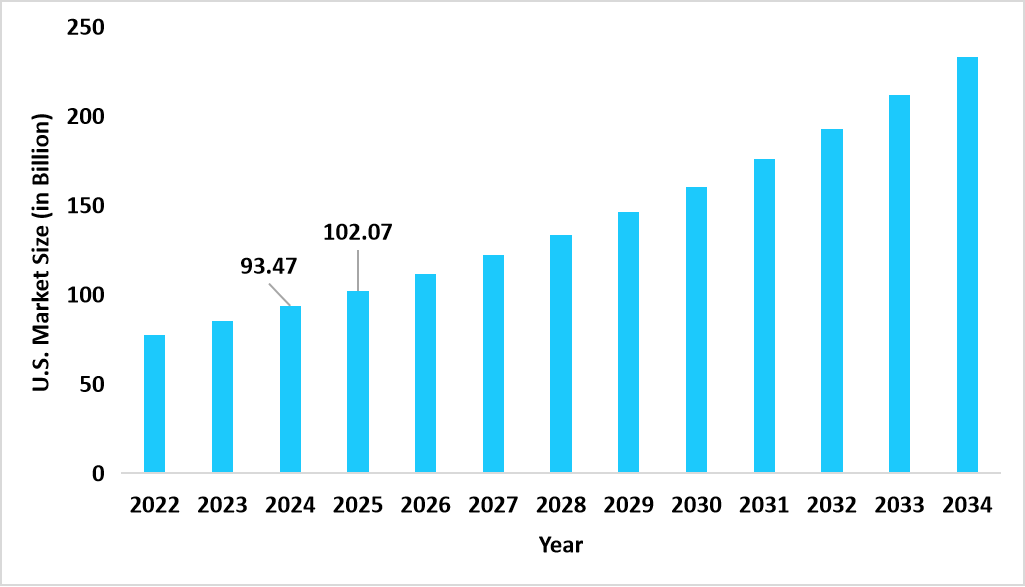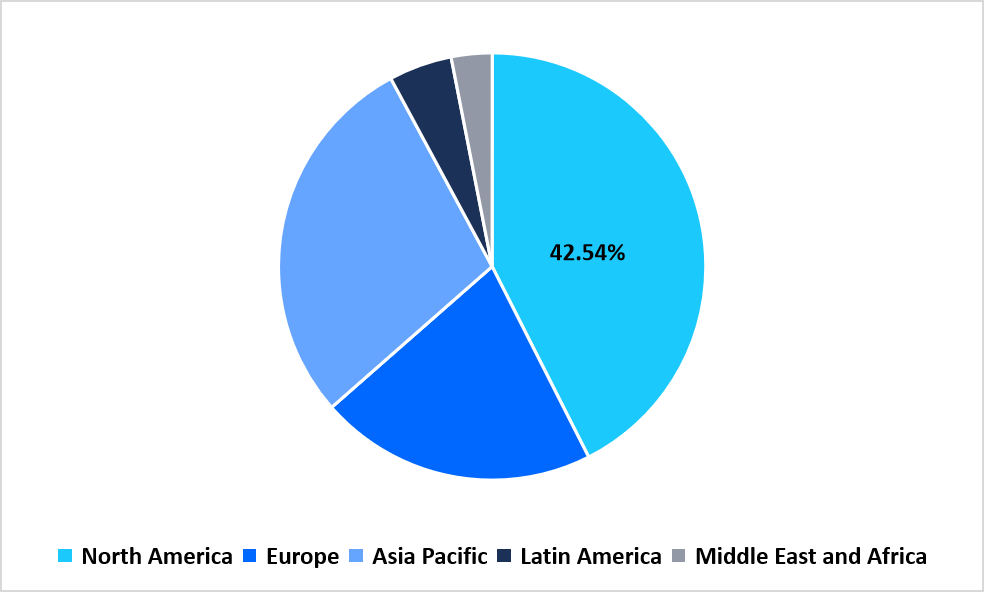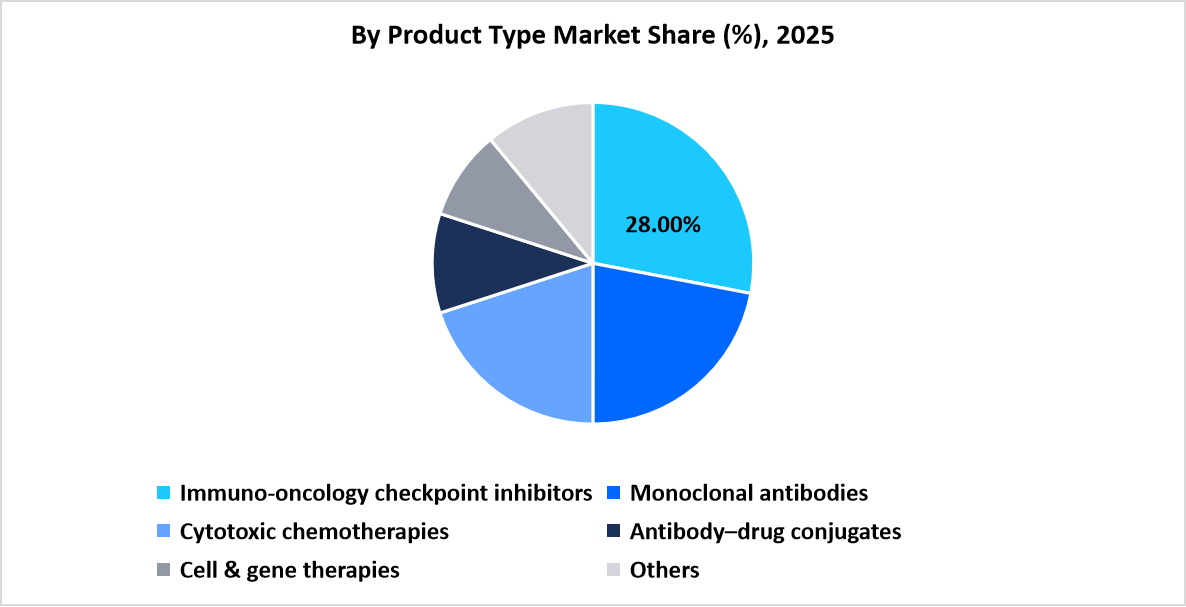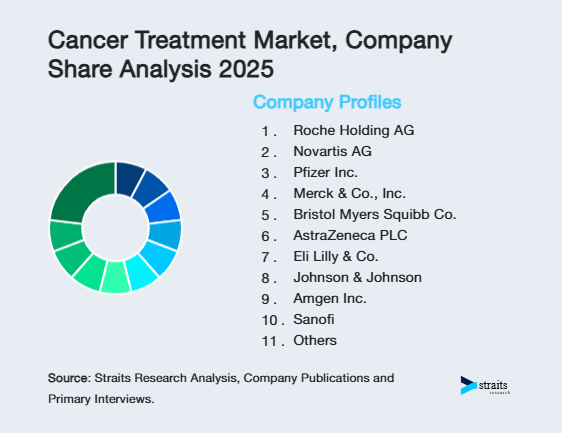Cancer Treatment Market Overview
The global cancer treatment market size is estimated at USD 282.28 billion in 2025 and is projected to reach USD 643.50 billion by 2034, growing at a CAGR of 9.63% during the forecast period. The remarkable growth of the market is due to the expanding therapeutic transformations and improved access to precision diagnostics.
Key Market Trends & Insights
- North America held a dominant share of the global market with a market share of 42.54% in 2025.
- The Asia Pacific region is growing at the fastest pace, with a CAGR of 10.20%.
- Based on cancer type, lung cancer dominates the market with a market revenue share of 26% in 2025.
- Based on product type, the immuno-oncology checkpoint inhibitors segment dominated the market with a revenue share of 28% in 2025.
- Based on end-user, hospitals and cancer centers dominated the market in 2025, with a revenue share of 58%.
- The U.S. dominates the market, valued at USD 93.47 billion in 2024 and reaching USD 102.07 billion in 2025.
Table: U.S. Cancer Treatment Market Size (USD Billion)

Source: Straits Research
Market Size & Forecast
- 2025 Market Size: USD 282.28 billion
- 2034 Projected Market Size: USD 643.50 billion
- CAGR (2026-2034): 9.63%
- Dominating Region: North America
- Fastest-Growing Region: Asia Pacific
The global market encompasses a wide array of therapies and solutions aimed at preventing, managing, and treating various forms of cancer. By type, the market includes breast cancer, lung cancer, colorectal cancer, prostate cancer, hematologic malignancies, pancreatic cancer, ovarian cancer, and other less common cancers. Breast and lung cancer treatments dominate the segment due to high prevalence rates and extensive research funding, while therapies for hematologic malignancies and rare cancers are rapidly gaining focus owing to advances in targeted and personalized medicine. By product, the market is segmented into cytotoxic chemotherapies, monoclonal antibodies, immuno-oncology checkpoint inhibitors, antibody-drug conjugates, cell and gene therapies, and other emerging treatment options. Cytotoxic chemotherapies remain widely used due to their established efficacy, while monoclonal antibodies and checkpoint inhibitors are witnessing rapid adoption driven by targeted treatment capabilities and improved patient outcomes. Novel modalities such as cell and gene therapies are experiencing strong growth, particularly in personalized oncology. By end user, hospitals and cancer centers represent the largest segment due to their capacity to provide specialized treatments and manage complex patient cases, followed by research and academic centers that contribute to clinical trials and advancements. Other end users, including outpatient clinics and home care services, are gradually expanding their presence as supportive and maintenance therapies become more accessible. Overall, the global market is experiencing potent growth fueled by rising cancer incidence, increasing awareness, technological advancements in therapies, and the expansion of healthcare infrastructure worldwide.
Latest Market Trends
Liquid Biopsy as the Clinical Gateway
Liquid biopsy is rapidly shifting into mainstream oncology practice, offering several advantages, as non-invasive tests, enabling earlier detection of actionable mutations, faster therapy initiation and reduced demand for invasive procedures. In May 2025, NHS England became the first to roll out a “blood test first” approach for cancer patients. The liquid biopsy test supported fast-tracking lung cancer patients in receiving targeted therapy up to two weeks earlier, while allowing few to avoid further tests and treatments, including chemotherapy, thereby improving patient outcomes and streamlining care pathways. This transition generated demand for diagnostic companies and pharmaceutical firms, as liquid biopsy served as a critical gateway for introducing advanced therapies, driving adoption of advanced treatments and supporting overall growth in the cancer treatment market.
Shift from Conventional CAR-T to In-Vivo CAR-T Delivery Platforms
The global market is witnessing a trend shifting from conventional ex vivo CAR-T therapies to in vivo delivery platforms, driven by the demand for broader patient access. For instance, in May 2025, AstraZeneca acquired EsoBiotec, a strategic M&A targeting in-vivo delivery platforms, particularly the Engineered NanoBody Lentiviral (ENaBL) platform. Such factor reduced per-patient cost, aligning it with the global demand for more accessible, next-generation immunotherapies. This shift also accelerated the adoption of advanced treatments across diverse healthcare settings.

To get more insights about this report Download Free Sample Report
Cancer Treatment Market Drivers
Private and Public R&D Investment and Targeted Acquisitions
The cancer treatment market growth is supported by strategic mergers and acquisitions that enhance R&D capabilities and expand product portfolios. Recently, Merck KGaA completed its acquisition of SpringWorks Therapeutics, a biopharmaceutical company focused on severe rare diseases and cancer, for USD 3.4 billion. This dual push reduced development risks and sped up commercialization timelines, which further ensured sustained market growth.
Market Restraint
Manufacturing and Supply Chain Challenges in Cancer Treatment
A restraint in the cancer treatment market is the manufacturing and supply chain challenges, particularly for advanced therapies such as CAR-T cells and gene therapies. According to the article published in the National Library of Medicine, CAR-T cell therapies required bespoke manufacturing with limited global capacity, leading to scheduling delays that impacted patient outcomes. Similarly, the supply of vectors for gene therapies and isotopes for radiopharmaceuticals remained constrained, increasing cost pressures and operational risks for manufacturers. Such bottlenecks slowed revenue generation despite therapy approvals and underscored the demand for expanded manufacturing infrastructure, optimized supply chains, and strategic planning to support the market’s growth.
Market Opportunity
AI and Computational Biology for Target ID and Engineered Biologics
AI and computational biology are transforming oncology R&D by accelerating target discovery, protein design and drug engineering, which presents as a market opportunity. Researchers at the Denmark Technical University (DTU) used AI to generate novel protein structures, showcasing potential for faster biologic engineering.
Such a factor reduced treatment timelines and costs by shortening design cycles and lowering attrition, increased productivity, and enabled the design of highly precise biologics that aligned with the move towards personalization.
Regional Analysis
North America dominated the market with a revenue share of 42.54% in 2025, attributed to the generous reimbursement frameworks. These frameworks ensured that patients could access advanced cancer treatments with minimal out-of-pocket expenses, encouraging higher adoption of advanced therapies.
The market growth in the U.S. is due to initiatives that improve patient access to advanced therapies. For instance, in December 2025, UC Davis Health’s Stem Cell Program had received a USD 500,000 grant from California health insurer Health Net to enhance cancer patients’ access to life-saving CAR T therapies and clinical trials. Such support reduced financial barriers, expanded treatment availability, and directly boosted the U.S. market growth.
Asia Pacific Market Insights
Asia Pacific is emerging as the fastest-growing region in the cancer treatment market, exhibiting a CAGR of 10.2% in 2025. This growth is attributed to increasing national health budgets, which enabled greater investment in advanced oncology infrastructure, wider accessibility to advanced therapies across the region.
The market in China is propelling due to the National Drug Price Negotiation policy, which has been instrumental in reducing the prices of anticancer drugs. AstraZeneca’s breast cancer drug Enhertu was added to China’s state insurance list, which resulted in an average price reduction of 63% for newly included drugs. Such policy enhanced the affordability as well as accessibility of cancer treatments, thereby expanding the market size of cancer treatment.
Table: Regional Market Share, 2025

Source: Straits Research
Europe Market Insights
A key driver of the European cancer treatment market is the strong support from the European Union through its Framework Programmes for Research and Innovation. These initiatives provide substantial funding for the development of advanced cancer therapies and diagnostics, enabling pharmaceutical companies, research institutes, and healthcare providers to innovate and adopt state-of-the-art treatment solutions. This strategic investment ensures that Europe remains at the forefront of oncology research, accelerates the availability of novel therapies, and strengthens the overall growth and competitiveness of the market across the region.
A driver propelling the UK's market is the advanced public and private investment in advanced cancer research and technology. UK Research and Innovation (UKRI) has allocated £12 million to 23 companies through the Cancer Therapeutics programme, focusing on developing life-changing treatments, including immunotherapies and vaccines.
Middle East and Africa Market Insights
A pivotal driver propelling the Middle East and Africa cancer treatment market is the surge in collaborative oncology research and clinical trials across the region. Notably, South Africa has emerged as a central hub for oncology studies, attracting global pharmaceutical and biotechnology companies due to its advanced medical facilities, skilled clinical research professionals, and diverse patient population. This trend is further bolstered by increasing collaborations with Contract Research Organizations (CROs), growing patient awareness about clinical trials, and substantial investments in research for non-communicable diseases, including cancer.
A key driver of the South Africa cancer treatment market is the increasing adoption of tele oncology and digital health platforms. With a large portion of the population residing in remote or underserved areas, telemedicine initiatives are enabling oncology specialists to remotely consult, monitor, and manage patients, bridging gaps in access to care. This digital transformation is supported by government programs and private sector investments aimed at expanding broadband infrastructure and e-health capabilities. As a result, patients can receive timely diagnosis, follow-up care, and personalized treatment plans without traveling long distances, improving treatment adherence and outcomes while accelerating the overall growth of the market in the region.
Latin America Market Insights
A driver of the Latin American cancer treatment market is the increasing participation in regional clinical trials for rare and hard-to-treat cancers. Countries like Brazil, Chile, and Colombia are emerging as preferred locations for international pharmaceutical companies to conduct oncology trials due to diverse patient populations, cost-efficient research infrastructure, and supportive regulatory frameworks. This trend not only accelerates the introduction of advanced therapies, such as CAR-T cell treatments and next-generation immunotherapies, but also strengthens local healthcare systems by enhancing diagnostic capabilities and specialist training.
The Argentine market is witnessing notable growth, driven by the integration of precision oncology and real-world evidence (RWE) initiatives. Leading hospitals and research centers in Buenos Aires and Córdoba are increasingly leveraging patient data, genomic profiling, and biomarker analyses to tailor therapies to individual patients, optimizing treatment outcomes.
Cancer Type Insights
Lung cancer dominates the market with a market revenue share of 26% in 2025. This growth is attributed to its rapid adoption of advanced targeted therapies and immunotherapies. The increasing approvals for EGFR, ALK, MET, RET, and KRAS targeted agents that have expanded treatment options and increased patient years on therapy.
The prostate cancer is anticipated to register the fastest CAGR of 10.63% during the forecast period, owing to the rising incidence of the disease, growing awareness of early detection, increased research funding for targeted therapies, and the introduction of advanced treatment options such as immunotherapies and personalized medicine.
Product Type Insights
The immuno-oncology checkpoint inhibitors segment dominated the market with a revenue share of 28% in 2025. The growth is attributed to several factors such as the increasing approval of novel PD-1 and PD-L1 inhibitors by regulatory authorities. These approvals expanded treatment options for multiple cancer types, improved patient survival rates, and encouraged wider adoption of checkpoint therapies.
The monoclonal antibodies segment is anticipated to register the fastest CAGR of 10.20% during the forecast period, owing to the growing adoption of targeted therapies, increasing prevalence of cancer, continuous advancements in biotechnology, and the rising number of regulatory approvals for novel monoclonal antibody therapies across multiple cancer types.

Source: Straits Research
End User Insights
Hospitals and cancer centers dominate the market and hold a revenue share of 58% in 2025. This growth is attributed to the adoption of complex and high value therapies offered there, such as antibody-drug conjugates (ADCs), and radioligand therapies (RLTs). These centers integrate advanced diagnostics, clinical trial access, and multidisciplinary teams, making them the first sites to adopt novel modalities.
The research and academic centers is estimated to register the fastest CAGR of 10.38% during the forecast period, owing to the increasing number of clinical trials, growing investments in oncology research, adoption of advanced technologies for cancer treatment development, and the rising focus on precision medicine and advanced therapeutic solutions.
Competitive Landscape
The global market is moderately fragmented in nature due to a large number of specialized biotech firms, niche reagent/manufacturing suppliers, academic spin outs and midsized cell therapy vendors operating alongside major pharmaceutical groups.
Allogene Therapeutics, Inc.: An emerging market player
Allogene Therapeutics, Inc., is an emerging player in the global market, focusing on the development of allogeneic CAR-T therapies to address unmet demands in oncology.
- In June 2024, Allogene Therapeutics, Inc. initiated the pivotal Phase 2 ALPHA3 trial to evaluate cemacabtagene ansegedleucel (cema-cel) as a consolidation therapy for patients with large B-cell lymphoma and minimal residual disease following first-line treatment, which aimed to establish the potential of cema-cel in preventing disease recurrence.
List of key players in Cancer Treatment Market
- Hoffmann-La Roche Ltd
- Novartis AG
- Pfizer Inc.
- Merck & Co., Inc.
- Bristol-Myers Squibb Company
- AstraZeneca
- Lilly USA, LLC
- Johnson & Johnson
- Amgen Inc.
- Sanofi
- Takeda Pharmaceutical Co.
- Bayer AG
- Astellas Pharma Inc.
- Ipsen
- BeiGene Ltd.
- EsoBiotec
- Zai Lab Ltd.
- Everest Medicines
- BioNTech
- Serum Institute of India Pvt. Ltd
- Others

To get more findings about this report Download Market Share
Strategic Initiatives
- June 2025: McKesson Corporation completed its acquisition of a controlling interest in Community Oncology Revitalisation Enterprise Ventures, LLC (Core Ventures), for approximately USD 2.49 billion. The acquisition is intended to accelerate clinical development and expand access to cancer care.
- June 2025: BMS and BioNTech entered a licensing agreement worth up to USD 11.1 billion, with a USD 1.5 billion upfront payment. The collaboration focused on a next-generation cancer drug, BNT327, a bispecific antibody in late-stage clinical trials.
- June 2025: The FDA approved taletrectinib for adults with locally advanced or metastatic ROS1-positive non-small cell lung cancer.
- August 2025: Everest Medicines announced that China’s NMPA approved its supplemental application for the production expansion of NEFECON. This supported in boosting capacity and also increased the supply of the product to meet growing clinical demand.
- March 2025: AstraZeneca agreed to acquire EsoBiotec for up to USD 1.0 billion, which validated the platform’s strategic value for scaling cell-therapy access.
- February 2025: Novartis announced its acquisition of Anthos Therapeutics for up to $3.1 billion, including a USD 925 million upfront payment. The deal strengthens Novartis's cardiovascular portfolio with a drug that is also being developed for cancer-associated thrombosis.
Report Scope
| Report Metric | Details |
|---|---|
| Market Size in 2025 | USD 282.28 billion |
| Market Size in 2026 | USD 308.44 billion |
| Market Size in 2034 | USD 643.50 billion |
| CAGR | 9.63% (2026-2034) |
| Base Year for Estimation | 2025 |
| Historical Data | 2022-2024 |
| Forecast Period | 2026-2034 |
| Report Coverage | Revenue Forecast, Competitive Landscape, Growth Factors, Environment & Regulatory Landscape and Trends |
| Segments Covered | By Cancer Type, By Product Type, By End-User, By Region. |
| Geographies Covered | North America, Europe, APAC, Middle East and Africa, LATAM, |
| Countries Covered | U.S., Canada, U.K., Germany, France, Spain, Italy, Russia, Nordic, Benelux, China, Korea, Japan, India, Australia, Taiwan, South East Asia, UAE, Turkey, Saudi Arabia, South Africa, Egypt, Nigeria, Brazil, Mexico, Argentina, Chile, Colombia, |
Explore more data points, trends and opportunities Download Free Sample Report
Cancer Treatment Market Segmentations
By Cancer Type (2022-2034)
- Breast Cancer
- Lung Cancer
- Colorectal Cancer
- Prostate Cancer
- Hematologic malignancies
- Pancreatic Cancer
- Ovarian Cancer
- Others
By Product Type (2022-2034)
- Cytotoxic chemotherapies
- Monoclonal antibodies
- Immuno-oncology checkpoint inhibitors
- Antibody-drug conjugates
- Cell & gene therapies
- Others
By End-User (2022-2034)
- Hospitals and cancer centers
- Research and academic centers
- Other
By Region (2022-2034)
- North America
- Europe
- APAC
- Middle East and Africa
- LATAM
Frequently Asked Questions (FAQs)
Debashree Bora
Healthcare Lead
Debashree Bora is a Healthcare Lead with over 7 years of industry experience, specializing in Healthcare IT. She provides comprehensive market insights on digital health, electronic medical records, telehealth, and healthcare analytics. Debashree’s research supports organizations in adopting technology-driven healthcare solutions, improving patient care, and achieving operational efficiency in a rapidly transforming healthcare ecosystem.
Speak To AnalystAvailable for purchase with detailed segment data, forecasts, and regional insights.
Get This ReportOur Clients:










































